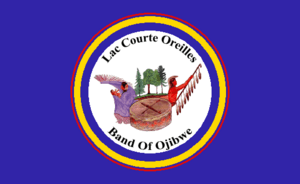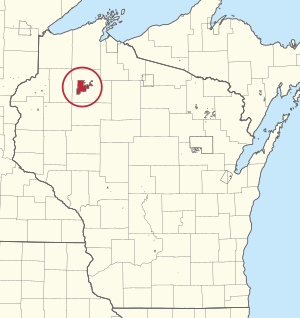Lac Courte Oreilles Band of Lake Superior Chippewa Indians facts for kids
| Ojibwe: Odaawaa-zaaga'iganiing | |
|---|---|

Flag of the Lac Courte Oreilles Band
|
|
| Total population | |
| 7,275 (2010) | |
| Regions with significant populations | |
| Languages | |
| English, Ojibwe | |
| Related ethnic groups | |
| other Ojibwe people |
The Lac Courte Oreilles Tribe (Ojibwe: Odaawaa-zaaga'iganiing) is one of six official groups of Ojibwe people in Wisconsin. In 2010, about 7,275 people were members of this tribe. The tribe lives on the Lac Courte Oreilles Indian Reservation in northwestern Wisconsin. This reservation surrounds a lake called Lac Courte Oreilles. In the Ojibwe language, this lake is called Odaawaa-zaaga'igan, which means "Ottawa Lake."
Most of the reservation land is in Sawyer County. There are also two smaller areas of tribal land in Rusk, Burnett, and Washburn counties. The reservation was created in 1854 by a special agreement called the second Treaty of La Pointe. The Lac Courte Oreille tribe had given up land in earlier agreements with the United States in 1837, 1842, and 1854. The reservation and its extra lands cover about 108 square miles (280 square kilometers). In 2020, about 2,968 people lived there. The biggest community on the reservation is Little Round Lake. It is located south of Hayward, a city that is not part of the reservation.
Contents
Exploring the Reservation Land
The Lac Courte Oreilles Reservation is mostly covered by forests and many lakes. To the northeast and east of the reservation is the Chequamegon–Nicolet National Forest. This forest was started in 1933 during the Great Depression. Before that, logging companies had cut down most of the trees. During the Depression, workers from the Civilian Conservation Corps planted new trees.
Today, both the reservation and the Chequamegon National Forest are growing back after the trees were cut down. Many lakes are found within or along the reservation's borders. Some of these lakes include Ashegon, Blueberry, Chief, Cristner, Devils, Green, Grindstone, Gurno, Lac Courte Oreilles, Lake Chippewa, Little Round, Little Lac Courte Oreilles, Pokegama, Rice, Scott, Osprey, Spring, Summit, and Tyner lakes.
Inside the reservation, there is also a protected area called the Grindstone Creek State Wildlife Management Area. Wild rice, known as manoomin in Ojibwe language, grows in many waterways on the reservation. The people of the reservation still gather this wild rice in the traditional way. It is a very important food for their community.
The reservation and its extra lands cover about 124 square miles (322 square kilometers) in total. About 108 square miles (280 square kilometers) of this is land, and 16 square miles (41 square kilometers) is water.
Who Lives on the Reservation?
The Lac Courte Oreilles Reservation is one of a few reservations where many non-Native people also live. This happened because of old agreements that allowed white settlers to stay on the land.
In 2020, the total number of people living on the Lac Courte Oreilles Reservation and its extra lands was 2,968. Most of the people (72.3%) were Native American. About 21.3% were White. A small number of people were Black or African American (0.2%), Pacific Islander (0.1%), or from other races (0.2%). About 6.0% of the people were from two or more races. About 1.7% of the population was Hispanic or Latino.
Tribal Government and Economy
The Lac Courte Oreilles Tribe is officially recognized by the United States government. This means they have their own elected government. This government includes a chairman and a tribal council. These leaders are chosen by the tribe's members and serve for four years. Elections happen every two years.
The tribe runs its own college, the Lac Courte Oreilles Ojibwa Community College, located in Hayward. They also own and operate the Sevenwinds Casino. The money earned from the casino helps support the tribe and its people. The tribe also has its own community radio station, WOJB-FM.
Every summer, the reservation hosts a special event called the "Honor the Earth" Pow Wow. A famous rock drummer named Mickey Hart recorded some of the music from this Pow Wow. His recording, Honor The Earth Powwow--Songs Of The Great Lake Indians, became quite popular in 1991.
A Look at History
The Anishinaabe people, who are part of the Algonquian languages family, came from the Atlantic Coast. They moved west and have lived in what is now northern Wisconsin for a very long time. According to the Seven fires prophecy, Anishinaabe leaders told their warriors to move west after they learned that other people had come from the East. They also sent soldiers as far east as Maine and as far south as Florida to protect their lands. A Native American historian named William W. Warren said that Anishinaabe people were living in northern Wisconsin even before 1492, when Christopher Columbus arrived in the Caribbean.
The Dakota Indians called the Anishinaabe the Ra-ra-to-oans, which means "People of the Falls." The French later used a similar name.
In the 1600s, French fur traders came to the area. This gave the Chippewa (Anishinaabe) a way to trade their hunting skills. In return, they received guns, knives, cloth, and other goods. These new products changed their way of life. The French fur traders were welcomed by the Chippewa because they learned the language and married Chippewa women.
Around 1661-1662, French fur traders named Radisson and Groseilliers traveled for four days from Madeline Island to a Huron Indian village. This village is thought to have been near the current village of Reserve on the Lac Courte Oreilles reservation. The French were allowed to use the Indian lands for travel.
During the 1600s and 1700s, the Santee Sioux (Dakota) and the Lake Superior Chippewa (Ojibwe/Anishinaabe) fought over control of northern Wisconsin and northeastern Minnesota. By the end of the 1700s, the Ojibwe had pushed the Dakota out of Wisconsin and much of northern Minnesota. The Dakota moved to areas west of the Mississippi River. Even though a treaty in 1825 said only a small part of Wisconsin was Dakota land, the Dakota and Ojibwe continued to fight over land for many years. In October 1842, the Battle of the Brule took place. It was a fight between the La Pointe Band of Ojibwe Indians and Dakota Indians, and the Ojibwe won.
Later, in the late 1700s and early 1800s, more wars happened between the Anishinaabeg and European Americans. After the War of 1812 between the US and Great Britain, the Great Lakes Anishinaabeg signed treaties with the United States. However, these agreements were not always kept. American settlers kept moving onto their lands around the Great Lakes. In 1854, the second Treaty of La Pointe with the US created what is now the Lac Courte Oreilles Reservation, along with other reservations for the Ojibwe in this area.
In the late 1800s, as more European Americans settled, the United States wanted to move all Native Americans from Michigan and Wisconsin to a reservation in Minnesota. But the tribes did not want to move. A small uprising happened in 1898 on the Leech Lake Indian Reservation in Minnesota. In the end, the US allowed the tribes to stay on smaller reservations in their home areas.
Communities on the Reservation
The Lac Courte Oreilles Reservation has several communities within its borders. Most of these communities have a large Native American population. Little Round Lake is the biggest community on the reservation. In 2010, 1,081 people lived there, and 90% of them were Native American.
Chief Lake is another community where most people are Native American (80%). New Post has 72% Ojibwe residents. In Reserve, 88% of the people are Native American. Northwoods Beach is on the west side of the reservation, between Grindstone Lake and Lac Courte Oreilles.
None of the communities on the Lac Courte Oreilles Reservation have grown into large cities or towns. Most of the people in Reserve live spread out, though the center of the community is a bit more crowded. Many homes in the community are located in the woods.
- Chief Lake
- Little Round Lake
- New Post
- Northwoods Beach
- Reserve
Notable Tribal Members
- Ah-shah-way-gee-she-go-qua (Aazhawigiizhigokwe, Hanging Cloud), a woman warrior from the Lac Courte Oreilles Ojibwe in the 1800s.
- David Wayne "Famous Dave" Anderson, a business owner.
- Diane Burns, a poet.
- Jim Denomie, a visual artist.
- Nenaa'angebi (Beautifying Bird), a leader of the Ojibwe in the 1800s.
- Ozaawindib (O-za-win-dib, also known as Yellow Head) was an Ojibwe chief in the 1700s. He was from the Prairie Rice Lake Band, which later joined the Lac Courte Oreilles Band. He was part of the Niibinaabe-doodem (Merman Clan). He fought in the Battle of Prairie Rice Lake in 1798. He was killed by a Dakota raider while hunting.
- Chief Zhaagobe (Six), another Ojibwe chief in the 1800s.


